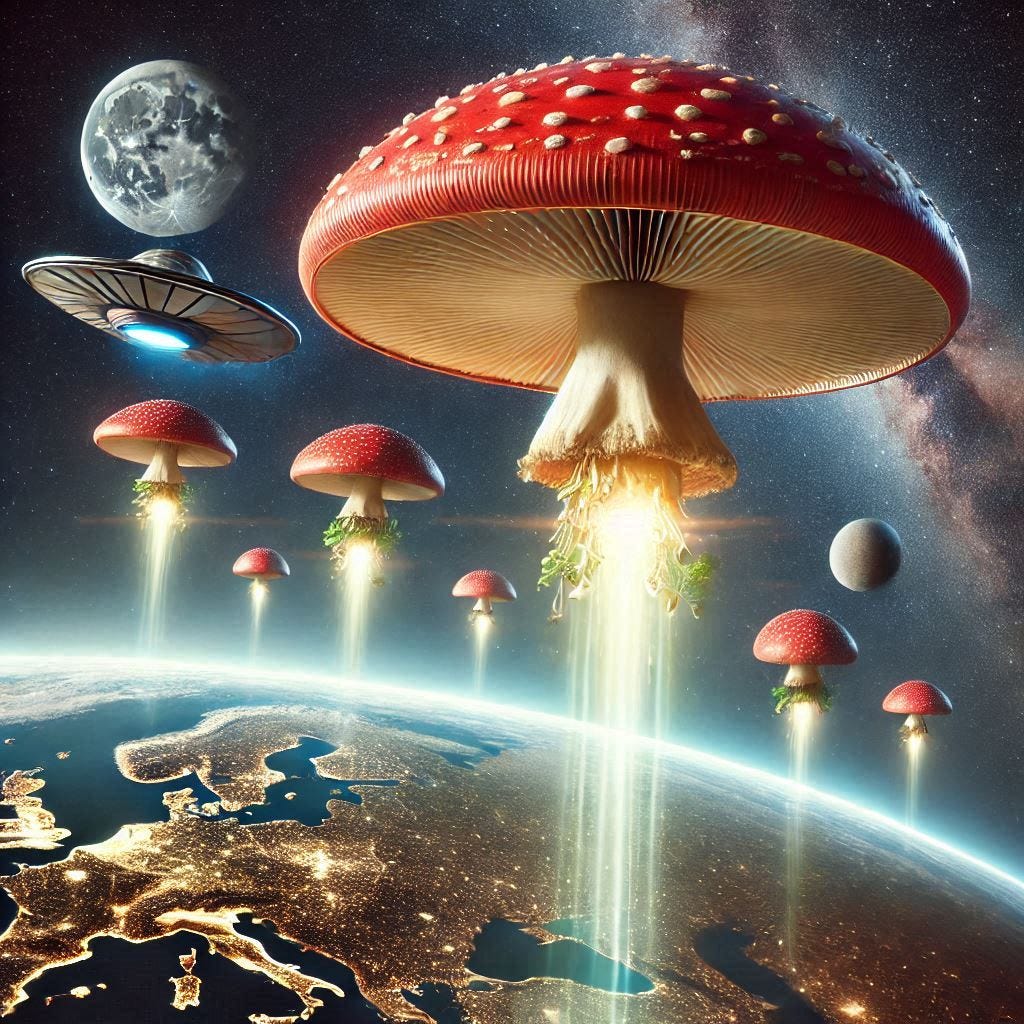Nature's Neural Networks
Fungal Cognition & the Classical Trivium
“I believe that mycelium is the neurological network of nature. Interlacing mosaics of mycelium infuse habitats with information-sharing membranes. These membranes are aware, react to change, and collectively have the long-term health of the host environment in mind. The mycelium stays in constant molecular communication with its environment, devising diverse enzymatic and chemical responses to complex challenges.” ― Paul Stamets
Nature’s Archetypal Trivium
The intelligence of fungi, particularly as expressed through their mycelial networks, is an emerging field that bridges biology, philosophy, and even metaphysics. Fungi exhibit behaviors that suggest a form of distributed intelligence, adaptive decision-making, and even a kind of awareness that challenges traditional definitions of consciousness.
When examined through the lens of the classical Trivium—Grammar, Logic, and Rhetoric—fungal intelligence reveals itself as a profound natural system of learning, processing, and expression. Furthermore, certain fungi, such as Lion’s Mane, Hericium erinaceus, and psilocybin-producing mushrooms, offer unique insights into how fungal intelligence may interface with human cognition and healing.
My article on the Trivium and Quadrivium:
The Power of Precision Thinking
“Logic is the source of eloquence, through which the wise who understand the … principal sciences and disciplines may discourse upon them more correctly, truly, and elegantly; more correctly, through Grammar; more truly, through Dialectic; more eloquently, through Rhetoric.” —St. Vincent of Beauvais
Cellular Intelligence: The Grammar of Fungi
At the cellular level, fungal hyphae demonstrate exquisite sensitivity to their environment. This foundational intelligence can be likened to Grammar in the Trivium: it provides the basic structure through which fungi interpret and interact with their surroundings. Hyphae navigate physical spaces with precision, responding to environmental stimuli such as surface ridges or chemical gradients.
The Spitzenkörper—a vesicle supply center at the hyphal tip—coordinates the delivery of materials for growth, akin to the grammatical rules that govern sentence construction. This cellular responsiveness is not merely reactive; it constitutes a form of “cellular consciousness,” where fungi perceive and respond to stimuli in ways that resemble neural action potentials in animals. Such behaviors suggest that fungi possess an innate “grammar” for organizing their growth and interactions.
Decision-Making and Network Logic
The mycelial network exemplifies Logic through its ability to process information and make decisions about resource allocation. Mycelium acts as a vast neural-like network within ecosystems, sending chemical signals across its web to assess resource availability, environmental conditions, and potential threats. These signals are analogous to neurotransmitters in animal nervous systems, allowing the network to integrate inputs from multiple sources and respond adaptively.
For example, mycelium demonstrates decision-making by rejecting harmful substrates while optimizing nutrient distribution across its network. This logical processing ensures the survival and efficiency of the fungal colony. Studies have shown that mycelia can “learn” from environmental stressors; for instance, exposure to heat shock primes them for faster responses to subsequent stress events. Such memory-like behaviors parallel neural plasticity in animals and underscore the logical sophistication of fungal networks.
Adaptive Communication: The Rhetoric of Mycelium
The culmination of fungal intelligence is its ability to communicate and express its “knowledge” through adaptive growth and reproduction—a process comparable to Rhetoric in the Trivium. Mycelial networks coordinate their responses across vast distances within ecosystems, effectively “speaking” through chemical signals that influence plant roots, other fungi, and even microbial communities. This communication is most vividly expressed when the mycelium produces fruiting bodies (mushrooms), which serve as both reproductive structures and expressions of accumulated environmental wisdom.
Mushrooms like Lion’s Mane and psilocybin-producing species extend this rhetorical capacity into interactions with humans. Lion’s Mane contains compounds that stimulate nerve growth factor (NGF), promoting neural regeneration and repair. Psilocybin mushrooms, on the other hand, facilitate profound shifts in human cognition by altering neural connectivity patterns. These fungi not only heal impaired neural structures but also open pathways to altered states of consciousness that resonate with the inherent intelligence of Earth’s biosphere.
Consciousness and Awareness
The question of fungal consciousness is complex but increasingly supported by evidence of their sensitivity, adaptability, memory, and decision-making capabilities. While fungi lack centralized brains, their distributed networks exhibit behaviors that align with definitions of awareness. Mycologists have observed anticipatory behaviors in pathogenic fungi that prepare for host immune responses before encountering them—a form of foresight embedded in their genetic programming.
This distributed awareness may represent a form of collective intelligence akin to what some philosophers describe as panpsychism: the idea that consciousness is a fundamental property of all matter. Within this framework, fungal networks could be seen as nodes in a larger web of planetary awareness—a “Wood Wide Web” connecting plants, microbes, animals, and humans.
Bridging Human Intelligence and Fungal Wisdom
The medicinal and psychedelic properties of certain mushrooms further highlight the potential for fungi to enhance human intelligence and healing. Lion’s Mane’s neuroregenerative effects suggest a direct interface between fungal compounds and human neural architecture. Psilocybin mushrooms go further by facilitating experiences of ego dissolution and interconnectedness—states often described as spiritual or transcendent. These experiences may reflect a resonance between human consciousness and the distributed intelligence of fungal networks.
By altering neural pathways and fostering new perspectives on selfhood and interconnectedness, psilocybin mushrooms provide a bridge between individual cognition and the broader intelligence of Earth’s biosphere. They invite us to reconsider our place within ecological systems—not as isolated beings but as participants in a vast network of life.
Healing Connections
Fungal intelligence operates at multiple levels: from cellular sensitivity (Grammar) to networked decision-making (Logic) to adaptive communication (Rhetoric). These behaviors challenge anthropocentric notions of consciousness by demonstrating how life can think without a brain or act without centralized control. Moreover, fungi like Lion’s Mane and psilocybin-producing species reveal profound connections between fungal wisdom and human cognition.
As we deepen our understanding of fungal intelligence—both scientifically and philosophically—we may uncover new ways to heal ourselves, our societies, and our planet. Fungi remind us that intelligence is not confined to humans or even animals; it is a pervasive property of life itself, woven into the very fabric of Earth’s biosphere. Through their networks, fungi teach us that knowledge is not merely stored or processed—it is lived, embodied, and shared across scales not only microscopic and planetary, but perhaps even cosmic!
Cosmic Connection?
The idea that fungal spores could originate from or survive in space has captivated scientists, philosophers, and astrobiologists alike. The remarkable resilience of fungal spores, their potential role in astrobiology, and their adaptability to extreme conditions provide fertile ground for exploring the hypothesis of panspermia—the notion that life, including fungi, may have been seeded on Earth from extraterrestrial sources.
Fungal spores are among the most robust biological structures on Earth. Their outer layers are electron-dense, ‘quasi-metallic,’ highly pigmented, and capable of withstanding extreme environmental stressors such as ultraviolet radiation, desiccation, and high vacuum. This feature provides protection against radiation and UV light while maintaining the spore’s viability. Such resilience has led researchers to consider that fungal spores could survive interplanetary journeys aboard meteoroids or comets—a key element of lithopanspermia, a form of panspermia where life is transported via rocky bodies.
Whatever their origins, fungi challenge anthropocentric views of intelligence and consciousness by demonstrating a distributed awareness that operates at both cellular and network levels. Whether as ancient terrestrial organisms or potential cosmic travelers, fungi remind us that life’s intelligence is not confined to centralized brains but is woven into the very fabric of biological systems. They invite us to see ourselves not as isolated beings but as participants in a planetary web of life—one that extends its roots into the cosmos itself. Through their networks, fungi offer a vision of interconnectedness that transcends Earthly boundaries, confirming that intelligence is a universal property embedded in the living systems of our universe.

Support Independent Research into Hidden Knowledge and Unexplored Horizons
Your engagement enables deep investigation into fundamental aspects of existence that mainstream academia often neglects. This work examines critical historical and scientific understanding through alternative perspectives.
🎯 Make a Direct Impact:
Ko-fi: ko-fi.com/alkemix
PayPal: paypal.me/alkemix33
Why Support?
Each contribution facilitates:
Investigation of overlooked historical evidence
Research into alternative scientific paradigms
Documentation of significant findings
Creation of original content that challenges conventional narratives
Whether you:
Share these insights with fellow researchers
Contribute to ongoing investigations
Engage in meaningful discourse
You're helping illuminate paths of knowledge that deserve deeper examination.
"The gift is to the giver, and comes back most to them" - Walt Whitman













The zombie ants very existence prove such fungal intelligence. Unfortunately this technology has already been weaponized to alter human DNA. This will soon be known as the second death written of in the Bible.
You are back! Great work!